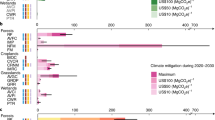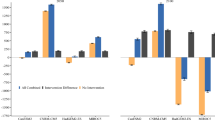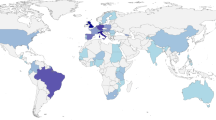Abstract
Natural climate solutions (NCS) play a critical role in climate change mitigation. NCS can generate win–win co-benefits for biodiversity and human well-being, but they can also involve trade-offs (co-impacts). However, the massive evidence base on NCS co-benefits and possible trade-offs is poorly understood. We employ large language models to assess over 2 million published journal articles, primarily written in English, finding 257,266 relevant studies on NCS co-impacts. Using machine learning methods to extract data (for example, study ___location, species and other key variables), we create a global evidence map on NCS co-impacts. We find that global evidence on NCS co-impacts has grown approximately tenfold in three decades, and some of the most abundant evidence relates to NCS that have lower mitigation potential. Studies often examine multiple NCS, indicating some natural complementarities. Finally, we identify countries with high carbon mitigation potential but a relatively weak body of evidence on NCS co-impacts. Through effective methods and systematic and representative data on NCS co-impacts, we provide timely insights to inform NCS-related research and action globally.
This is a preview of subscription content, access via your institution
Access options
Access Nature and 54 other Nature Portfolio journals
Get Nature+, our best-value online-access subscription
27,99 € / 30 days
cancel any time
Subscribe to this journal
Receive 12 digital issues and online access to articles
118,99 € per year
only 9,92 € per issue
Buy this article
- Purchase on SpringerLink
- Instant access to full article PDF
Prices may be subject to local taxes which are calculated during checkout





Similar content being viewed by others
Data availability
All data and materials used in the analysis are available at our GitHub repository at https://github.com/lexunit-ai/ncs-evidence-map.
Code availability
Code used for this study is available at our GitHub repository at https://github.com/lexunit-ai/ncs-evidence-map.
References
Griscom, B. W. et al. Natural climate solutions. Proc. Natl Acad. Sci. USA 114, 11645–11650 (2017).
Kikstra, J. S. et al. The IPCC Sixth Assessment Report WGIII climate assessment of mitigation pathways: from emissions to global temperatures. Geosci. Model Dev. 15, 9075–9109 (2022).
Crumpler, K. et al. Assessing the role of agriculture and land use in nationally determined contributions: a methodology. In Environment and Natural Resources Management Working Paper 76 (Food and Agriculture Organization of the United Nations, 2019).
Fargione, J. E. et al. Natural climate solutions for the united states. Sci. Adv. 4, eaat1869 (2018).
Cook-Patton, S. C. et al. Protect, manage and then restore lands for climate mitigation. Nat. Clim. Change 11, 1027–1034 (2021).
Smith, P. et al. Land-management options for greenhouse gas removal and their impacts on ecosystem services and the sustainable development goals. Annu. Rev. Environ. Resour. 44, 255–286 (2019).
Opportunities to Accelerate Nature-Based Solutions: A Roadmap for Climate Progress, Thriving Nature, Equity, & Prosperity (White House Council on Environmental Quality, White House Office of Science and Technology Policy & White House Domestic Climate Policy Office, 2022).
Nature and Net Zero (McKinsey Consulting & World Economic Forum, 2021).
Executive Order N-82-20 (Executive Department State of California, 2020).
Anderson, C. M. et al. Natural climate solutions are not enough. Science 363, 933–934 (2019).
Girardin, C. A. et al. Nature-based solutions can help cool the planet — if we act now. Nature 593, 191–194 (2021).
IPCC Special Report on Climate Change and Land (eds Shukla, P. R. et al.) (Cambridge Univ. Press, 2019).
Transforming Our World: The 2030 Agenda for Sustainable Development (United Nations, 2015).
United Nations Framework Convention on Climate Change. Paris Agreement. In Report of the Conference of the Parties to the United Nations Framework Convention on Climate Change 1–42 (HeinOnline, 2015).
The Kunming-Montreal Global Biodiversity Framework (United Nations Environment Programme, 2022).
Pörtner, H.-O. et al. IPBES-IPCC Co-Sponsored Workshop Report on Biodiversity and Climate Change (IPBES-IPCC, 2021).
Dasgupta, P. The Economics of Biodiversity: The Dasgupta Review (HM Treasury, 2021).
Emissions Gap Report: The Heat is On – A World of Climate Promises Not Yet Delivered (United Nations Environment Programme, 2021).
Roe, S. et al. Land-based measures to mitigate climate change: potential and feasibility by country. Glob. Change Biol. 27, 6025–6058 (2021).
Shindell, D. et al. Simultaneously mitigating near-term climate change and improving human health and food security. Science 335, 183–189 (2012).
Stewart, R. B., Oppenheimer, M. & Rudyk, B. A new strategy for global climate protection. Climatic Change 120, 1–12 (2013).
Seddon, N. et al. Understanding the value and limits of nature-based solutions to climate change and other global challenges. Phil. Trans. R. Soc. B 375, 20190120 (2020).
Schulte, I., Eggers, J., Nielsen, J. Ø. & Fuss, S. What influences the implementation of natural climate solutions? A systematic map and review of the evidence. Environ. Res. Lett. 17, 013002 (2022).
Brown, S. E., Miller, D. C., Ordonez, P. J. & Baylis, K. Evidence for the impacts of agroforestry on agricultural productivity, ecosystem services, and human well-being in high-income countries: a systematic map protocol. Environ. Evid. 7, 24 (2018).
Shimamoto, C. Y., Padial, A. A., da Rosa, C. M. & Marques, M. C. Restoration of ecosystem services in tropical forests: a global meta-analysis. PLOS ONE 13, e0208523 (2018).
Hua, F. et al. The biodiversity and ecosystem service contributions and trade-offs of forest restoration approaches. Science 376, 839–844 (2022).
Snilstveit, B., Vojtkova, M., Bhavsar, A., Stevenson, J. & Gaarder, M. Evidence & gap maps: a tool for promoting evidence informed policy and strategic research agendas. J. Clin. Epidemiol. 79, 120–129 (2016).
McKinnon, M. C. et al. What are the effects of nature conservation on human well-being? A systematic map of empirical evidence from developing countries. Environ. Evid. 5, 8 (2016).
Berrang-Ford, L. et al. A systematic global stocktake of evidence on human adaptation to climate change. Nat. Clim. Change 11, 989–1000 (2021).
Callaghan, M. et al. Machine-learning-based evidence and attribution mapping of 100,000 climate impact studies. Nat. Clim. Change 11, 966–972 (2021).
Game, E. T. et al. Cross-discipline evidence principles for sustainability policy. Nat. Sustain. 1, 452–454 (2018).
Haynes, R. B., Wilczynski, N., McKibbon, K. A., Walker, C. J. & Sinclair, J. C. Developing optimal search strategies for detecting clinically sound studies in medline. J. Am. Med. Inform. Assoc. 1, 447–458 (1994).
Westgate, M. J., Barton, P. S., Pierson, J. C. & Lindenmayer, D. B. Text analysis tools for identification of emerging topics and research gaps in conservation science. Conserv. Biol. 29, 1606–1614 (2015).
Berrang-Ford, L. et al. Systematic mapping of global research on climate and health: a machine learning review. Lancet Planet. Health 5, e514–e525 (2021).
Porciello, J., Ivanina, M., Islam, M., Einarson, S. & Hirsh, H. Accelerating evidence-informed decision-making for the Sustainable Development Goals using machine learning. Nat. Mach. Intell. 2, 559–565 (2020).
Porciello, J., Lipper, L. & Ivanina, M. Using machine learning to evaluate 1.2 million studies on small-scale farming and post-production food systems in low-and middle-income countries. Front. Sustain. Food Syst. 6, 1013701 (2023).
Edwards, K. et al. ADVISE: accelerating the creation of evidence syntheses for global development using natural language processing-supported human-artificial intelligence collaboration. J. Mech. Des. 146, 051404 (2024).
Chausson, A. et al. Mapping the effectiveness of nature-based solutions for climate change adaptation. Glob. Change Biol. 26, 6134–6155 (2020).
Vera-Baceta, M.-A., Thelwall, M. & Kousha, K. Web of Science and Scopus language coverage. Scientometrics 121, 1803–1813 (2019).
Konno, K. & Pullin, A. S. Assessing the risk of bias in choice of search sources for environmental meta-analyses. Res. Synth. Methods 11, 698–713 (2020).
Blevins, T. & Zettlemoyer, L. Language contamination helps explains the cross-lingual capabilities of English pretrained models. In Proc. 2022 Conference on Empirical Methods in Natural Language Processing 3563–3574 (Association for Computational Linguistics, 2022).
Huang, H. et al. Not all languages are created equal in LLMs: improving multilingual capability by cross-lingual-thought prompting. In Conference on Empirical Methods in Natural Language Processing 12365–12394 (Association for Computational Linguistics, 2023).
Bang, Y. et al. A multitask, multilingual, multimodal evaluation of ChatGPT on reasoning, hallucination, and interactivity. In Proc. 13th International Joint Conference on Natural Language Processing and the 3rd Conference of the Asia-Pacific Chapter of the Association for Computational Linguistics (Volume 1: Long Papers) 675–718 (Association for Computational Linguistics, 2023).
Hendy, A. et al. How good are GPT models at machine translation? A comprehensive evaluation. Preprint at https://arxiv.org/abs/2302.09210 (2023).
Dobrescu, A. et al. Restricting evidence syntheses of interventions to English-language publications is a viable methodological shortcut for most medical topics: a systematic review. J. Clin. Epidemiol. 137, 209–217 (2021).
Amano, T. et al. Tapping into non-English-language science for the conservation of global biodiversity. PLOS Biol. 19, e3001296 (2021).
Seddon, N. et al. Getting the message right on nature-based solutions to climate change. Glob. Change Biol. 27, 1518–1546 (2021).
Mikolov, T., Chen, K., Corrado, G. S. & Dean, J. Efficient estimation of word representations in vector space. In International Conference on Learning Representations: Proc. International Conference on Learning Representations Workshop Track 1301–3781 (ICLR, 2013).
Bommarito, M. J., Katz, D. M. & Detterman, E. M. LexNLP: natural language processing and information extraction for legal and regulatory texts. in Research Handbook on Big Data Law 216–227 (Edward Elgar Publishing, 2021).
Petry, W. K. & Levine, J. M. A meta-analysis of the biodiversity co-benefits of NCS (2023).
Cook-Patton, S. C. et al. Mapping carbon accumulation potential from global natural forest regrowth. Nature 585, 545–550 (2020).
Busch, J. et al. Potential for low-cost carbon dioxide removal through tropical reforestation. Nat. Clim. Change 9, 463–466 (2019).
Chapman, M. et al. Large climate mitigation potential from adding trees to agricultural lands. Glob. Change Biol. 26, 4357–4365 (2020).
Griscom, B. W. et al. National mitigation potential from natural climate solutions in the tropics. Phil. Trans. R. Soc. B 375, 20190126 (2020).
Lipsett-Moore, G. J., Wolff, N. H. & Game, E. T. Emissions mitigation opportunities for savanna countries from early dry season fire management. Nat. Commun. 9, 2247 (2018).
Sanderman, J., Hengl, T. & Fiske, G. J. Soil carbon debt of 12,000 years of human land use. Proc. Natl Acad. Sci. USA 114, 9575–9580 (2017).
Liu, H. et al. Annual dynamics of global land cover and its long-term changes from 1982 to 2015. Earth Syst. Sci. Data 12, 1217–1243 (2020).
The IUCN Red List of Threatened Species (Version 2022-2) (IUCN, 2022).
Smits, J. & Permanyer, I. The Subnational Human Development Database. Sci. Data 6, 190038 (2019).
Poverty and Shared Prosperity 2022: Correcting Course (World Bank, 2022).
de Castañeda, R. R. et al. One Health and planetary health research: leveraging differences to grow together. Lancet Planet. Health 7, e109–e111 (2023).
Osaka, S., Bellamy, R. & Castree, N. Framing “nature-based” solutions to climate change. WIREs Clim. Change 12, e729 (2021).
Deutz, A. et al. Financing Nature: Closing the Global Biodiversity Financing Gap (The Paulson Institute, The Nature Conservancy & the Cornell Atkinson Center for Sustainability, 2020).
Austin, K. et al. The economic costs of planting, preserving, and managing the world’s forests to mitigate climate change. Nat. Commun. 11, 5946 (2020).
Halterman, A. Mordecai: Full text geoparsing and event geocoding. J. Open Source Softw. 2, 91 (2017).
IUCN Global Standard for Nature-Based Solutions: A User-Friendly Framework for the Verification, Design and Scaling Up of NbS (IUCN, 2020).
Ellis, P. W. et al. The principles of natural climate solutions. Nat. Commun. 15, 547 (2024).
Howard, J. et al. Blue carbon pathways for climate mitigation: known, emerging and unlikely. Mar. Policy 156, 105788 (2023).
Reimers, N. & Gurevych, I. Sentence-BERT: sentence embeddings using Siamese BERT-networks. In Proc. 2019 Conference on Empirical Methods in Natural Language Processing and the 9th International Joint Conference on Natural Language Processing (EMNLP-IJCNLP) 3982–3992 (Association for Computational Linguistics, 2019).
Grootendorst, M. R. et al. MaartenGr/BERTopic: v0.12.0 (v0.12.0). Zenodo https://doi.org/10.5281/zenodo.7068172 (2022).
Falkenberg, M. et al. Growing polarization around climate change on social media. Nat. Clim. Change 12, 1114–1121 (2022).
Weng, M.-H., Wu, S. & Dyer, M. Identification and visualization of key topics in scientific publications with transformer-based language models and document clustering methods. Appl. Sci. 12, 11220 (2022).
OpenTreeofLife et al. Open Tree of Life taxonomy (v. 13.4). Zenodo https://doi.org/10.5281/zenodo.3937750 (2021).
Boyd-Graber, J., Hu, Y. & Mimno, D. et al. Applications of topic models. Foundations and Trends® in Information Retrieval 11, 143–296 (2017).
Farrell, J. Corporate funding and ideological polarization about climate change. Proc. Natl Acad. Sci. USA 113, 92–97 (2016).
Marlow, T., Miller, S. & Roberts, J. T. Bots and online climate discourses: Twitter discourse on President Trump’s announcement of US withdrawal from the Paris Agreement. Clim. Policy 21, 765–777 (2021).
Chang, C. H., Armsworth, P. R. & Masuda, Y. J. Environmental discourse exhibits consistency and variation across spatial scales on Twitter. BioScience 72, 789–797 (2022).
Chang, C. H., Armsworth, P. R. & Masuda, Y. J. Twitter data reveal six distinct environmental personas. Front. Ecol. Environ. 20, 481–487 (2022).
Hristova, G. & Netov, N. Media coverage and public perception of distance learning during the COVID-19 pandemic: a topic modeling approach based on BERTopic. In Proc. 2022 IEEE International Conference on Big Data (Big Data) 2259–2264 (IEEE Publishing, 2022).
Munger, K., Bonneau, R., Nagler, J. & Tucker, J. A. Elites tweet to get feet off the streets: measuring regime social media strategies during protest. Polit. Sci. Res. Methods 7, 815–834 (2019).
Liebman, B. L., Roberts, M. E., Stern, R. E. & Wang, A. Z. Mass digitization of Chinese court decisions: how to use text as data in the field of Chinese law. J. Law Courts 8, 177–201 (2020).
Horowitz, M. et al. What makes foreign policy teams tick: explaining variation in group performance at geopolitical forecasting. J. Politics 81, 1388–1404 (2019).
Hopkins, D. J. & King, G. A method of automated nonparametric content analysis for social science. Am. J. Polit. Sci. 54, 229–247 (2010).
DiMaggio, P. Adapting computational text analysis to social science (and vice versa). Big Data Soc. https://doi.org/10.1177/2053951715602908 (2015).
Devlin, J., Chang, M.-W., Lee, K. & Toutanova, K. BERT: pre-training of deep bidirectional transformers for language understanding. In Proc. 2019 Conference of the North American Chapter of the Association for Computational Linguistics: Human Language Technologies, Volume 1 (Long and Short Papers) 4171–4186 (Association for Computational Linguistics, 2019); https://aclanthology.org/N19-1423
McInnes, L., Healy, J., Saul, N. & Großberger, L. UMAP: uniform manifold approximation and projection for dimension reduction. J. Open Source Softw. 3, 861 (2018).
McInnes, L., Healy, J. & Astels, S. hdbscan: hierarchical density based clustering. J. Open Source Softw. 2, 205 (2017).
Harris, J. M. & Roach, B. Environmental and Natural Resource Economics: A Contemporary Approach (Routledge, 2017).
Friedman, R. S. et al. Analyzing procedural equity in government-led community-based forest management. Ecol. Soc. 25, 16 (2020).
Kato-Huerta, J. & Geneletti, D. Environmental justice implications of nature-based solutions in urban areas: a systematic review of approaches, indicators, and outcomes. Environ. Sci. Policy 138, 122–133 (2022).
Dawson, N. M. et al. The role of Indigenous peoples and local communities in effective and equitable conservation. Ecol. Soc. 26, 19 (2021).
Garnett, S. T. et al. A spatial overview of the global importance of Indigenous lands for conservation. Nat. Sustain. 1, 369–374 (2018).
Blanco, G. D. et al. The impacts of mining on the food sovereignty and security of Indigenous peoples and local communities: a global review. Sci. Total Environ. 855, 158803 (2023).
Hill, R. et al. Working with Indigenous, local and scientific knowledge in assessments of nature and nature’s linkages with people. Curr. Opin. Environ. Sustain. 43, 8–20 (2020).
McElwee, P. et al. Working with Indigenous and local knowledge (ILK) in large-scale ecological assessments: reviewing the experience of the IPBES global assessment. J. Appl. Ecol. 57, 1666–1676 (2020).
Schlingmann, A. et al. Global patterns of adaptation to climate change by Indigenous peoples and local communities. A systematic review. Curr. Opin. Environ. Sustain. 51, 55–64 (2021).
Keith, D. A. et al. A function-based typology for Earth’s ecosystems. Nature 610, 513–518 (2022).
Rees, J. A. & Cranston, K. Automated assembly of a reference taxonomy for phylogenetic data synthesis. Biodivers. Data J. 5, e12581 (2017).
Acknowledgements
We are grateful to J. Levine, W. Petry, B. Griscom, F. Seymour, C. Girardin, L. Olander, N. Deshmukh and several others for their thoughtful feedback, as well as attendees at various presentations that strengthened our analysis and manuscript. We thank D. Lovas for technical contributions that greatly enhanced the manuscript. The findings and conclusions in this publication are those of the authors and should not be construed to represent any official USDA or US government determination or policy. Funding from the Bezos Earth Fund and other donors supporting The Nature Conservancy benefited this project48,49,71,73,74,75,76,77,78,79,80,81,82,83,84,85,86,87,88,89,90,91,92,93,94,95,96,97,98.
Author information
Authors and Affiliations
Contributions
C.H.C., B.E.R., J.T.E., L.L., Y.J.M., I.M., D.P. and P.F. conceived the idea for the manuscript, generated new methods and performed the research. C.H.C., B.E.R., J.T.E., Y.J.M., I.M., D.P. and S.C.-P. performed data analysis and modelling, generated figures and tables, and drafted sections of the manuscript. A.R.T., S.C.-P., R.I.M., T.G., J.P.H., P.W.E., E.E.P., T.K., S.H.C., P.W., S.A.W., M.C., L.S.S., K.G.A. and P.F. performed critical reviews. Y.J.M., E.E.P., J.T.E. and R.I.M. obtained funding.
Corresponding author
Ethics declarations
Competing interests
The authors declare no competing interests.
Peer review
Peer review information
Nature Sustainability thanks Akira Mori, Todd Rosenstock and the other, anonymous, reviewer(s) for their contribution to the peer review of this work.
Additional information
Publisher’s note Springer Nature remains neutral with regard to jurisdictional claims in published maps and institutional affiliations.
Supplementary information
Supplementary Information
Supplementary Figs. 1–7, Tables 1–17 and Discussion.
Rights and permissions
Springer Nature or its licensor (e.g. a society or other partner) holds exclusive rights to this article under a publishing agreement with the author(s) or other rightsholder(s); author self-archiving of the accepted manuscript version of this article is solely governed by the terms of such publishing agreement and applicable law.
About this article
Cite this article
Chang, C.H., Erbaugh, J.T., Fajardo, P. et al. Global evidence of human well-being and biodiversity impacts of natural climate solutions. Nat Sustain 8, 75–85 (2025). https://doi.org/10.1038/s41893-024-01454-z
Received:
Accepted:
Published:
Issue Date:
DOI: https://doi.org/10.1038/s41893-024-01454-z



